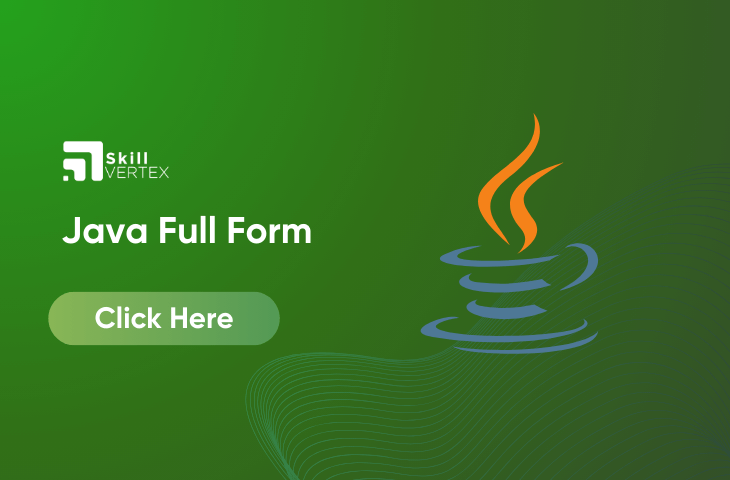Table of Contents
Java Full Form
The name JAVA is a computer-based programming language that functions to develop computer-based applications. It does not have a specific full form or neither an abbreviation. Hence, the ‘Just Another Virtual Accelerator’ is a fictionalized complete version of JAVA and the name is put forward by the general public.
Java – Enabling Innovation and Development Across the Digital Landscape.Java, a versatile and dynamic programming language, has played a pivotal role in shaping the modern digital world. The term “Java” is often associated with coffee, but in the realm of technology, it represents a language that has revolutionized software development, providing a platform that is robust, portable, and conducive to building a wide array of applications, from web and mobile to enterprise solutions and embedded systems.
Java Full Form- Origin and Evolution:
Java’s journey began in the early 1990s when a team of developers at Sun Microsystems, led by James Gosling, set out to create a programming language that could overcome the limitations of existing languages. The result was Java, introduced in 1995.
The language was designed with the principle of “write once, run anywhere” (WORA) in mind, aiming to be platform-independent and capable of running on any system with a Java Virtual Machine (JVM). This concept revolutionized the way software was developed and deployed.
Java Full Form -Versatility and Cross-Platform Compatibility
One of the primary strengths of Java is its ability to run on multiple platforms without the need for recompilation. This is achieved through the use of the Java Virtual Machine, which acts as an intermediary between the compiled Java code and the underlying hardware.
This cross-platform compatibility has been a driving force behind Java’s widespread adoption. Developers can create applications on one platform and have the confidence that they will run seamlessly on various operating systems, from Windows and macOS to Linux and beyond.
Java Full Form- Object-Oriented Nature
Java’s object-oriented nature has been a cornerstone of its popularity. Everything in Java is an object, promoting modular and organized programming. This facilitates code reuse, maintenance, and collaboration among developers. Object-oriented principles like encapsulation, inheritance, and polymorphism have enabled the creation of efficient and well-structured codebases.
Java Full Form – Robustness and Reliability
Java places a strong emphasis on robustness and reliability. Its strict type-checking and automatic memory management through the garbage collection process help prevent common programming errors such as memory leaks and null pointer exceptions.
This has made Java a favored choice for building critical systems where stability and predictability are paramount, such as financial applications, healthcare systems, and telecommunications infrastructure.
Java Full Form – Rich Standard Library
Java comes with a comprehensive standard library that provides a wide range of pre-built classes and packages for various purposes. This saves developers time and effort, as they can utilize these built-in functionalities rather than reinventing the wheel. From handling input/output operations to working with data structures and networking, the Java standard library offers a plethora of tools to expedite development.
Java Full Form- Security Considerations
Security has been both a strength and a challenge for Java. While Java’s architecture promotes strong security features, such as sandboxing to prevent unauthorized access and execution, it has also faced security vulnerabilities over the years. These vulnerabilities have led to the need for frequent updates and patches to ensure the safety of Java applications.
Java Full Form- Community and Ecosystem
The vibrant and active Java community has contributed to the language’s continuous growth and evolution. The open-source nature of many Java frameworks, libraries, and tools has fostered an ecosystem that supports diverse application development needs.
Platforms like Apache Maven, Spring Framework, and Hibernate have gained immense popularity within the Java ecosystem, aiding developers in various aspects of their projects.
Java Full Form- Conclusion
In the realm of software development, Java stands as a testament to innovation and adaptability. Its inception marked a turning point in programming languages, introducing a new level of portability and reliability. Java’s ability to thrive in a rapidly changing technological landscape is a testament to its enduring relevance.
From enterprise applications to mobile apps and embedded systems, Java continues to empower developers to bring their ideas to life while embracing the principles of versatility, security, and robustness. As the digital world continues to evolve, Java remains a steadfast companion, enabling the creation of cutting-edge solutions that shape our connected future.
FAQ- Java Full Form
Q1. What Java means?
Ans. Java is a multi-platform, object-oriented, and network-centric language that can be used as a platform in itself. It is a fast, secure, reliable programming language for coding everything from mobile apps and enterprise software to big data applications and server-side technologies.
Q2.What is Java’s first name?
Ans. The language was initially called Oak after an oak tree that stood outside Gosling’s office. Later the project went by the name Green and was finally renamed Java, from Java coffee, a type of coffee from Indonesia
Q3. Why Java is used?
Ans. Java was designed to be easy to use and is therefore easy to write, compile, debug, and learn than other programming languages. Java is object-oriented. This allows you to create modular programs and reusable code. Java is platform-independent
Hello, I’m Hridhya Manoj. I’m passionate about technology and its ever-evolving landscape. With a deep love for writing and a curious mind, I enjoy translating complex concepts into understandable, engaging content. Let’s explore the world of tech together

